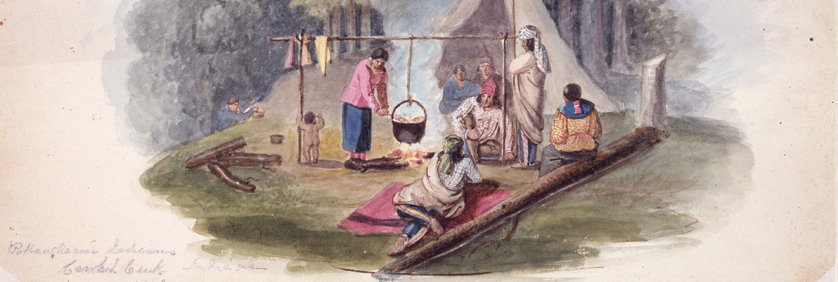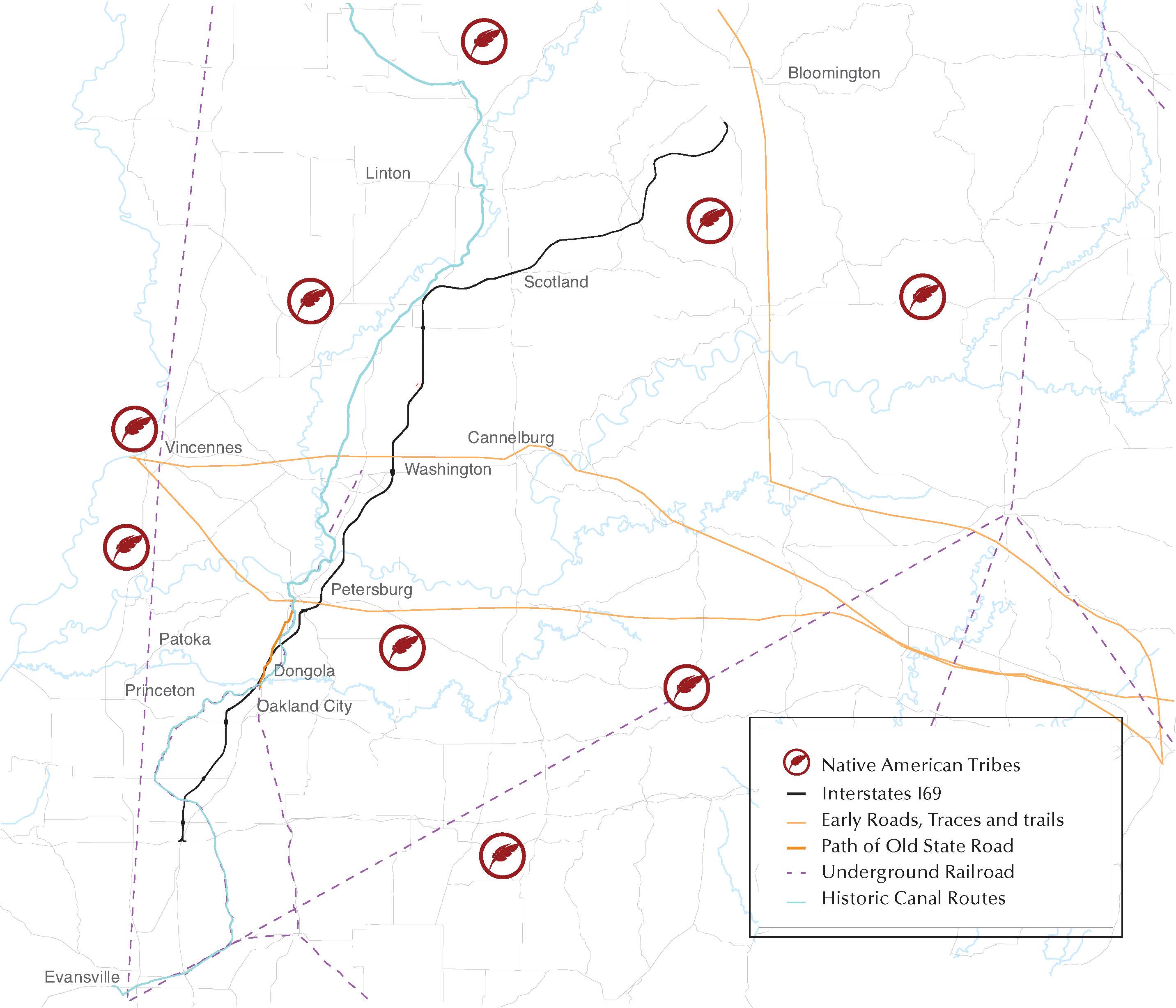This audio tour presents “Native American Tribes,” one of a series of vignettes that recounts the history of the land now bisected by I-69 between I-64 and Bloomington, Indiana. Choose one or all of the vignettes to learn about the cultural and natural landscape along I-69. The map provides general locations of Native American tribes in southwestern Indiana.
Native Americans living in this region in the eighteenth and nineteenth centuries encountered more Euro-American traders, trappers, and settlers pushing west than had previous generations. Constantin Volney provides a late-eighteenth century account of an encounter with Native American tribes in the Northwest Territory from the vantage of a French traveler.
“My stay at Vincennes afforded me some knowledge of the Indians, who were there assembled to barter away the produce of their . . . hunt. There were four or five hundred of them, men, women, and children, of various tribes, as the Weeaws, Payories, Sawkies, Pyankishaws, and Miamis, all living near the head of the Wabash. This was the first opportunity I had of observing, at my leisure, a people who have already become rare east of the Allegheny.”—Constantin F. Volney, 17961
- Read More


George Winter traveled to the frontier in the 1830s and created a series of paintings of Native American life, this one is of a Potawatomi Family. (Tippecanoe County Historical Society)By the time most Euro-Americans came into contact with Native Americans, sequential waves of introduced diseases had eroded populations. Foreign and intertribal conflict had resulted in major displacements. And, finally, the fur trade and agricultural production had begun a transformation of the natural and cultural environment.
Many tribes in this region had either left or been forcibly expelled from their former homelands along the East Coast as Europeans and Euro-Americans expanded their settlements inland. By the eighteenth century, tribes within the state included, but were not limited to, the Delaware, Kickapoo, Miami, Piankeshaw, Potawatomi, Shawnee, and Wea.[1] Some Delaware had settled along the White River in the 1770s, with the consent of the Miami and Piankeshaw who were already in the region.[2] The Shawnee, who had been pushed west by Euro-Americans, had lived in southern Indiana before moving northeast along the Wabash River.[3] The Potawatomi were concentrated along the St. Joseph and Kankakee rivers in northern Indiana.[4] Many tribes in this area had called the lands now known as New York, Pennsylvania, Michigan, and Canada home.
Each tribe had a distinct culture and way of life, though some similarities were shared. For example, houses were often constructed with a framework of sapling trees and covered with large sheets of bark or mats woven with cattails or other reeds. Communities likely alternated between semi-permanent summer villages near waterways and more short-term winter camps.[5] Women were seasoned farmers, cultivating large fields of corn, beans, and squash, in addition to gathering wild plants and nuts with the children. Men of the tribe hunted, fished, and trapped.[6]
A variety of tools used in this era were often a mixture of traditional and European-produced materials. For example, stone and antler spear and arrow points gave way to metal points, which were then largely replaced by firearms. Native Americans traded furs, copper, and other goods for woolen blankets, kettles, pipes, ribbon, and glass beads.[7]
Decades of warfare between 1780 and 1814 and numerous land cessions whittled down the once vast Native American homelands to disconnected, scattered reserves. European settlement increased rapidly. Most of the land in southwestern Indiana had been ceded in the treaties at Vincennes and Fort Wayne. By the early nineteenth century, these federal treaties increasingly promoted tribal indebtedness, acculturation, and removal.[8]
Tecumseh, a Shawnee warrior, chief, and leader of a multi-tribe confederacy expressed the frustration of many Native Americans when he addressed territorial governor William Henry Harrison in 1810:
Brother, since the peace was made you have killed some of the [Shawnee, Winnebago, Delaware and Miami] and you have taken our lands from us, and I do not see how we can remain at peace with you if you continue to do so. You have given goods to the Kickapoos for the sale of their land which has been the cause of many deaths among them. You have promised us assistance but I do not see that you have given us any.
--Tecumseh’s Speech to Governor Harrison, August 20, 1810.[9]Many of the Shawnee had moved to Ohio in the years following the Treaty of Greenville.[10] In the years between 1818 and 1840, after Indiana attained statehood, the largest tribes affected by the treaties and removals were the Delaware, Potawatomi, and
Miami.[11] In 1846, the Miami people were the last of the tribes in the state to be forcibly removed.[12]
Federal treaties, policies, and acts dramatically changed the cultural landscape of Indiana in the nineteenth century. Despite these upheavals, Indiana counts just over 55,000 American Indian or Alaska Native residents living in the state in 2010.[13] As of June 2019, there were 5423 citizens enrolled in the Miami Tribe, with about 700 of those living in Indiana.[14] In the words of the American Indian Center of Indiana, Native Americans “were, and still are, important participants in the culture and history of Indiana.”[15]
If you are looking for more information about contemporary Native Americans see the Resources Page for links.
[1] The Piankeshaw and Wea are considered subgroups of the Miami Nation.
[2] Removal History, Official Website of the Delaware Tribe of Indians, http://delawaretribe.org/services-and-programs/historic-preservation/removal-history-of-the-delaware-tribe/; David Vanderstel, “Native Americans,” Conner Prairie, https://www.connerprairie.org/educate/indiana-history/native-americans-in-indiana/.
[3] Vanderstel, “Native Americans.”
[4] Elizabeth Glenn & Stewart Rafert, The Native Americans (Indianapolis: Indiana Historical Society Press, 2009), 36-37.
[5] Ellen Sieber and Cheryl Ann Munson, Looking at History: Indiana’s Hoosier National Forest Region,
1600 to 1950 (Bloomington and Indianapolis: Indiana University Press, 1994), 19.
[6] Stewart Rafert, The Miami Indians of Indiana: A Persistent People 1654-1994 (Indianapolis: Indiana Historical Society, 1996), 12-13.
[7] Sieber and Munson, Looking at History, 20-21; Glenn & Rafert, The Native Americans, 23.
[8] Jefferson encouraged indebtedness through the fur trade, which was still active in Indiana. After trading for goods at “usually rather steep prices,” tribes would be forced to cede land in treaties to pay off their debts. To a lesser extent, federal treaties encouraged some form of acculturation, such as in an 1818 treaty with the Miami that granted the tribe a sawmill and gristmill. See: Glenn and Rafert, Native Americans, 51-52.
[9] Indiana Historical Society, http://images.indianahistory.org/cdm/ref/collection/dc007/id/19
[10] Glenn and Rafert, Native Americans, 43.
[11] Glenn and Rafert, Native Americans, 59.
[12] George Strack et al, “myaamiaki aancihsaaciki: A Cultural Exploration of the Myaamia Removal Route, Miami Tribe of Oklahoma,” 2011, accessed February 20, 2018, http://myaamiacenter.org/wp-content/uploads/2013/02/myaamia_removal.pdf; Glenn and Rafert, Native Americans, 47-52.
[13] This number includes all persons with tribal affiliations living in the state.
[14] Information provided by the Miami Tribe of Oklahoma.
[15] “Education & Culture,” American Indian Center of Indiana, Inc., http://www.americanindiancenter.org/info.php?pnum=8.
Places Of Occupation, Native American Tribes

